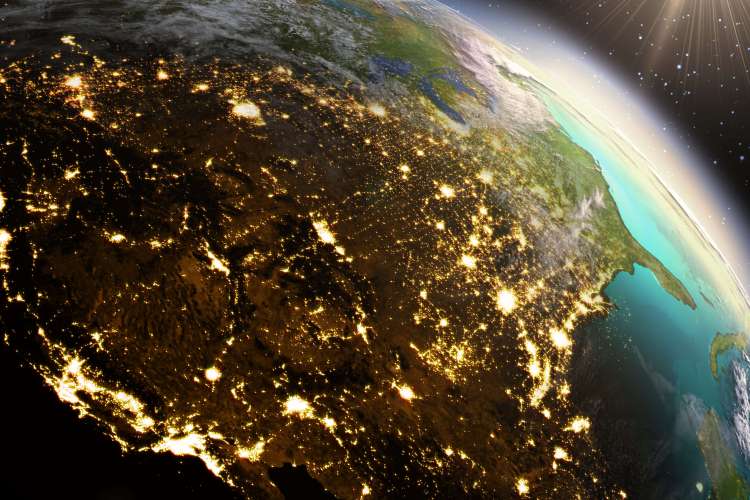Five percent of carbon emissions between the atmosphere, biosphere, and oceans are attributed to human activity. Although seemingly small, this amount disrupts the Earth’s natural carbon cycle and drives long-term climate change.
Being able to regularly identify and monitor the largest sources of carbon generation due to human activity will have a significant impact on how we manage solutions to reduce these types of greenhouse emissions. With the emergence of low-cost small satellites featuring advanced on-board Artificial Intelligence (AI) processing, The Aerospace Corporation has developed a novel carbon dioxide (CO2) and carbon monoxide (CO) remote sensing system called CarbonWatch®.

CarbonWatch® has the ability to measure prominent greenhouse gases regardless of visible light levels, providing a 24-hour day/night space-based remote sensing system. This day/night capability can help spot variability in near surface carbon plumes—a source for which few direct measurements exist.
Sensing in the Dark
Contemporary remote sensing instruments observe background concentrations of greenhouse gases but are limited in their ability to tease out human-made contributions. In addition, existing sensors are confined to when and what they can observe: able to only measure in daylight with long periods in-between revisiting the same geographic areas.
A group of Aerospace scientists and engineers responded to these technological limitations and looked to advance current industry capabilities by developing CarbonWatch®, which relies on mid-infrared spectral remote sensing capabilities.
“Shortwave and near infrared sensors require sunlight, whereas longwave instruments can measure carbon dioxide at night but cannot measure carbon monoxide,” said Dr. Katherine Saad, a research scientist in the Imaging Spectroscopy Department. “With mid-infrared, you get the best of the infrared spectrum.”
The instrument’s sensors can measure CO2 and CO signals independent from sunlight, using a simplified architecture that can be replicated and an automated onboard processing system.

The device will measure exchanges from specific point sources, such as power plants, oil refineries, or wildfires. Scientists can then integrate this data with background CO2 measurements to parse out which facilities are producing carbon dioxide and exacerbating the global cycle’s imbalance.
“Observations by CarbonWatch® will inform scientists on the current status of carbon use,” said Dr. John Hackwell, an Aerospace Technical Fellow and the project lead. “The data collected can be applied to global climate-related discussions, such as the Paris Agreement.”
Strength in Numbers
To note if differing levels of carbon are emitted throughout a 24-hour period, the team envisions a constellation of 25 CarbonWatch® sensors to yield twice daily coverage of the Earth, unlike existing sensors. This future aim guided how the project was approached from the beginning and set the intent to keep the instrument’s burden on its host spacecraft as small as possible.
“Having multiple satellites means that if one of them fails, you haven’t jeopardized your whole mission,” said Hackwell. “Coverage will go down a little, but not a lot. Your mission is still intact. You can still observe and collect data.”
In the end, the sensor is compact in terms of size, weight, and power. Noting the effect a payload can have on its future host, the team designed the instrument to be adaptable—able to be part of a larger bus or a standalone 12U CubeSat. Elements that are traditionally burdensome, such as a sensor’s need to be actively pointed, were also removed. The technology scans nadir directly below at the Earth’s surface at the orbital rate of the host spacecraft, observing roughly 100 km swaths at a time.
The sensor was designed with proliferation and manufacturability in mind. CarbonWatch® is optimized to meet the global greenhouse gas monitoring mission by using readily available parts for a low-cost production environment.
Using AI to Automate
A challenge for post-data collection is that the raw information from the constellation of spectral sensors is too much to send back to the ground. To overcome this potential obstacle, CarbonWatch® will have an onboard processing capability. Aerospace has been a pioneer in Artificial Intelligence/Machine Learning (AI/ML) for spectral remote sensing and is applying this strength to develop algorithms for processing the spectral data. Once trained, the algorithms will be completely automated and enable the spacecraft to send back identified emitters to the ground system.
Currently, the Aerospace team is finalizing and submitting proposals for CarbonWatch® to transition from concept to tangible reality. In the future, a constellation of these sensors could be observing during the day and night—collecting data to quantify emissions and provide a fuller image of how our activities affect the carbon cycle.
“CarbonWatch® will contribute to a broader understanding of Earth science, while also taking note of point emitters,” said Hackwell. “Being aware of specific sources is particularly useful for future conversations about the effects of human activity on climate change.

